Strategic Resourcing and Talent Planning Report for Marks and Spencer
VerifiedAdded on 2023/01/16
|16
|5353
|82
Report
AI Summary
This report delves into the critical aspects of resourcing and talent planning within the context of Marks & Spencer. It begins by examining contemporary labor market trends in the UK and US, followed by an analysis of how organizations strategically position themselves in competitive markets, including an exploration of the 'Employer of Choice' model. The report then explores the significance of tight and loose labor market conditions and the roles of government, employers, and trade unions in meeting future skills needs. It outlines principles and tools for effective workforce planning, including succession and career development plans. Furthermore, the report investigates the legal requirements of recruitment and selection, and the strengths and weaknesses of different methods. It also addresses employee retention strategies and the management of dismissals, retirements, and redundancies, aligning with current legislation. The report provides a comprehensive overview of resourcing and talent planning, offering valuable insights for organizational success.
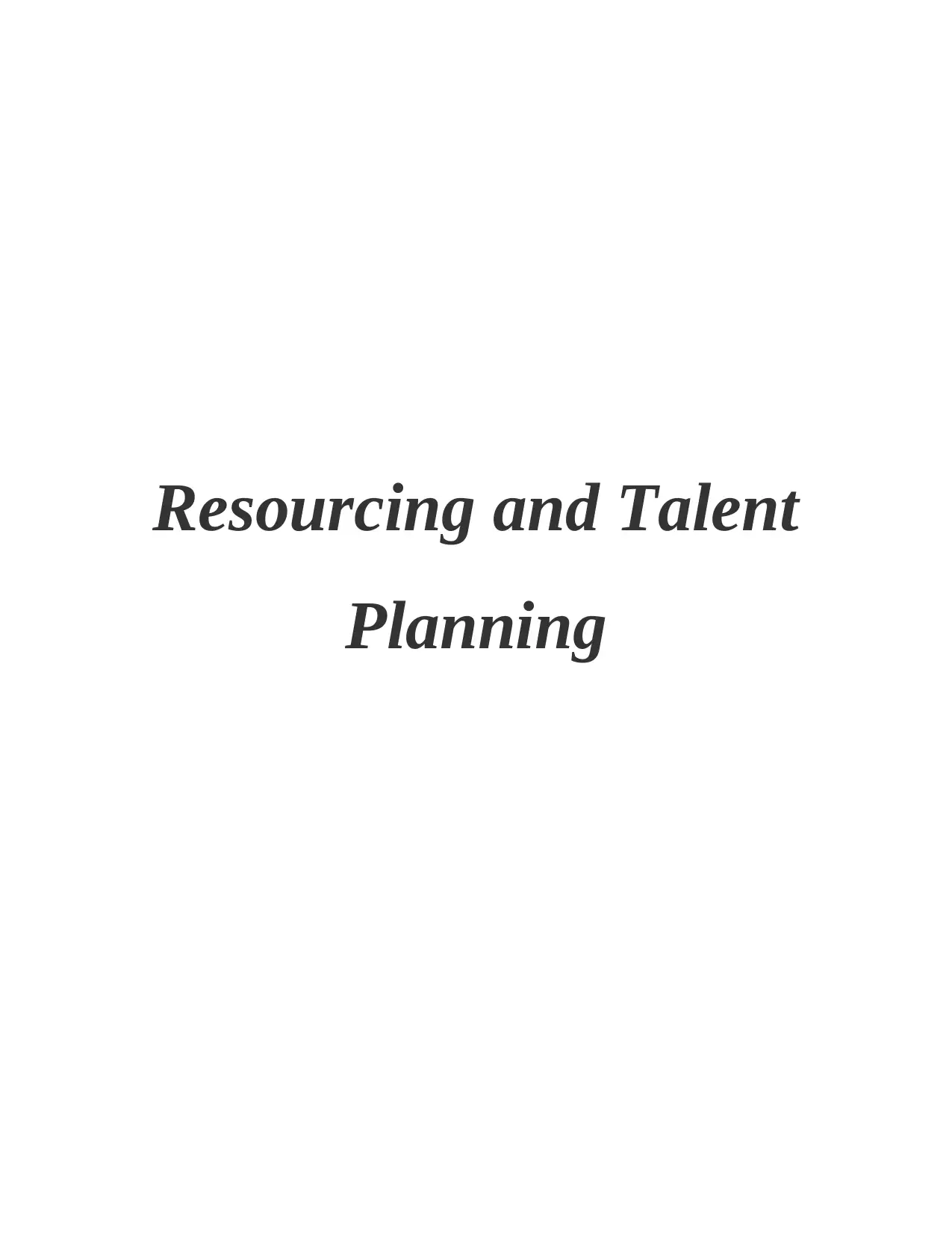
Resourcing and Talent
Planning
Planning
Paraphrase This Document
Need a fresh take? Get an instant paraphrase of this document with our AI Paraphraser
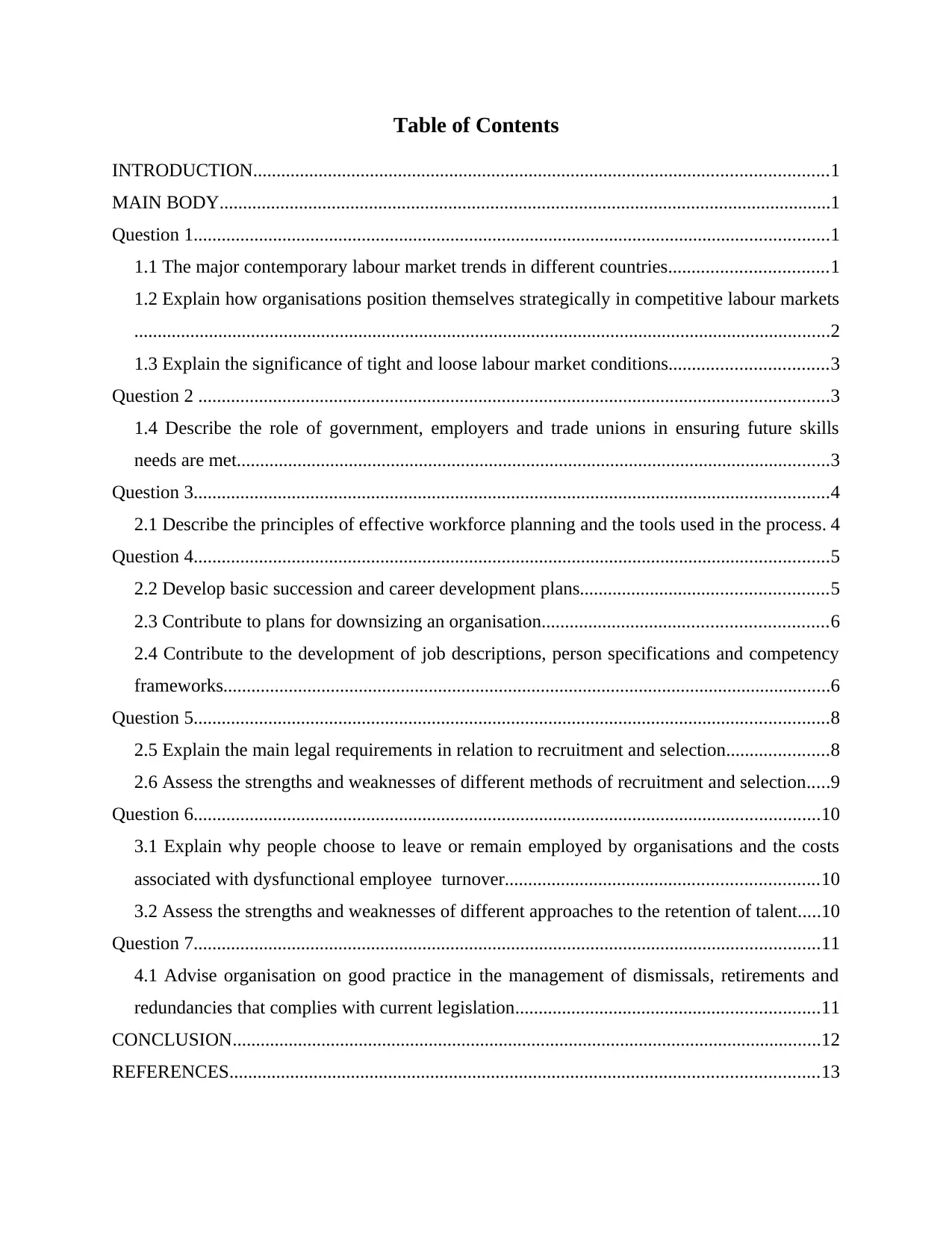
Table of Contents
INTRODUCTION...........................................................................................................................1
MAIN BODY...................................................................................................................................1
Question 1........................................................................................................................................1
1.1 The major contemporary labour market trends in different countries..................................1
1.2 Explain how organisations position themselves strategically in competitive labour markets
.....................................................................................................................................................2
1.3 Explain the significance of tight and loose labour market conditions..................................3
Question 2 .......................................................................................................................................3
1.4 Describe the role of government, employers and trade unions in ensuring future skills
needs are met...............................................................................................................................3
Question 3........................................................................................................................................4
2.1 Describe the principles of effective workforce planning and the tools used in the process. 4
Question 4........................................................................................................................................5
2.2 Develop basic succession and career development plans.....................................................5
2.3 Contribute to plans for downsizing an organisation.............................................................6
2.4 Contribute to the development of job descriptions, person specifications and competency
frameworks..................................................................................................................................6
Question 5........................................................................................................................................8
2.5 Explain the main legal requirements in relation to recruitment and selection......................8
2.6 Assess the strengths and weaknesses of different methods of recruitment and selection.....9
Question 6......................................................................................................................................10
3.1 Explain why people choose to leave or remain employed by organisations and the costs
associated with dysfunctional employee turnover...................................................................10
3.2 Assess the strengths and weaknesses of different approaches to the retention of talent.....10
Question 7......................................................................................................................................11
4.1 Advise organisation on good practice in the management of dismissals, retirements and
redundancies that complies with current legislation.................................................................11
CONCLUSION..............................................................................................................................12
REFERENCES..............................................................................................................................13
INTRODUCTION...........................................................................................................................1
MAIN BODY...................................................................................................................................1
Question 1........................................................................................................................................1
1.1 The major contemporary labour market trends in different countries..................................1
1.2 Explain how organisations position themselves strategically in competitive labour markets
.....................................................................................................................................................2
1.3 Explain the significance of tight and loose labour market conditions..................................3
Question 2 .......................................................................................................................................3
1.4 Describe the role of government, employers and trade unions in ensuring future skills
needs are met...............................................................................................................................3
Question 3........................................................................................................................................4
2.1 Describe the principles of effective workforce planning and the tools used in the process. 4
Question 4........................................................................................................................................5
2.2 Develop basic succession and career development plans.....................................................5
2.3 Contribute to plans for downsizing an organisation.............................................................6
2.4 Contribute to the development of job descriptions, person specifications and competency
frameworks..................................................................................................................................6
Question 5........................................................................................................................................8
2.5 Explain the main legal requirements in relation to recruitment and selection......................8
2.6 Assess the strengths and weaknesses of different methods of recruitment and selection.....9
Question 6......................................................................................................................................10
3.1 Explain why people choose to leave or remain employed by organisations and the costs
associated with dysfunctional employee turnover...................................................................10
3.2 Assess the strengths and weaknesses of different approaches to the retention of talent.....10
Question 7......................................................................................................................................11
4.1 Advise organisation on good practice in the management of dismissals, retirements and
redundancies that complies with current legislation.................................................................11
CONCLUSION..............................................................................................................................12
REFERENCES..............................................................................................................................13
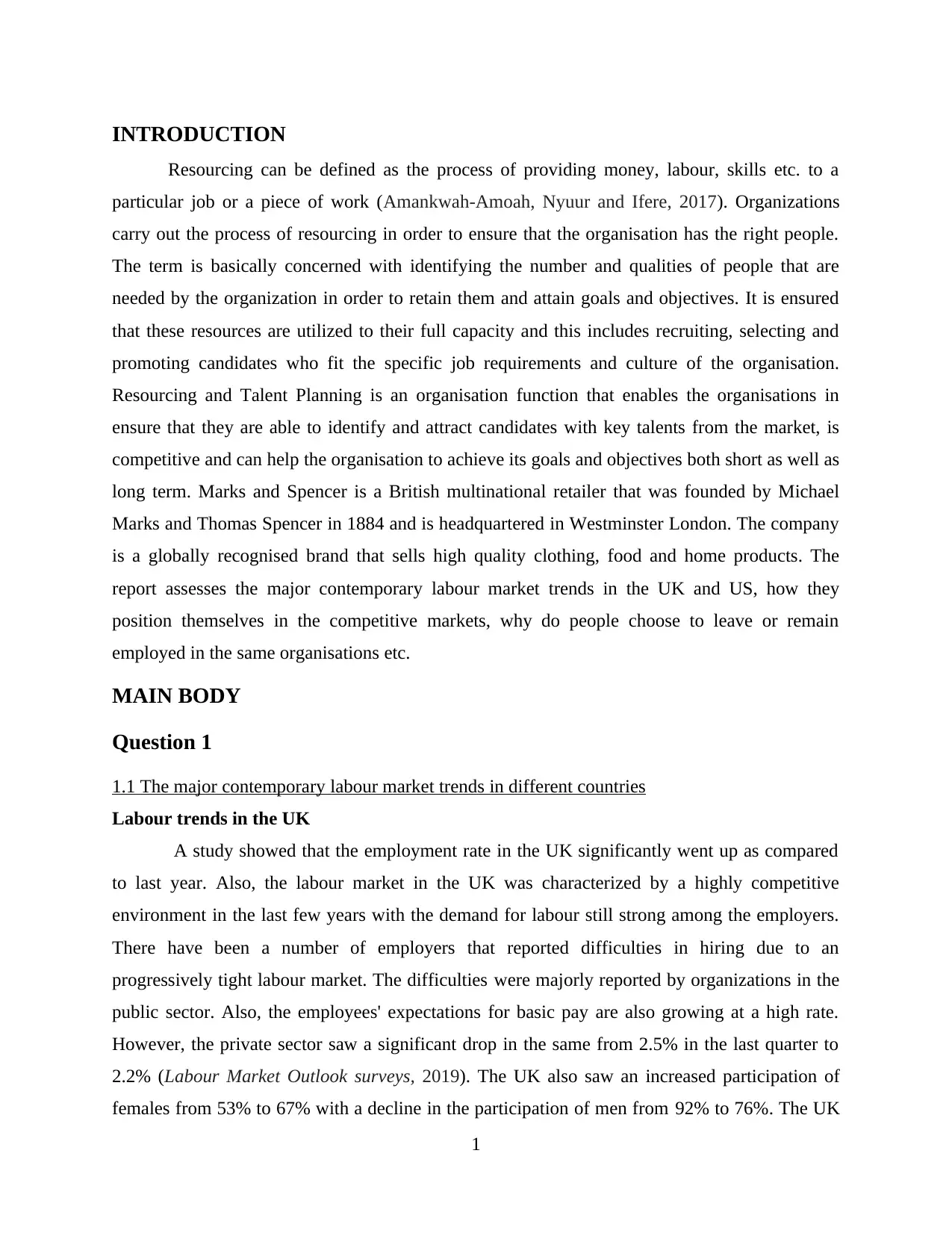
INTRODUCTION
Resourcing can be defined as the process of providing money, labour, skills etc. to a
particular job or a piece of work (Amankwah-Amoah, Nyuur and Ifere, 2017). Organizations
carry out the process of resourcing in order to ensure that the organisation has the right people.
The term is basically concerned with identifying the number and qualities of people that are
needed by the organization in order to retain them and attain goals and objectives. It is ensured
that these resources are utilized to their full capacity and this includes recruiting, selecting and
promoting candidates who fit the specific job requirements and culture of the organisation.
Resourcing and Talent Planning is an organisation function that enables the organisations in
ensure that they are able to identify and attract candidates with key talents from the market, is
competitive and can help the organisation to achieve its goals and objectives both short as well as
long term. Marks and Spencer is a British multinational retailer that was founded by Michael
Marks and Thomas Spencer in 1884 and is headquartered in Westminster London. The company
is a globally recognised brand that sells high quality clothing, food and home products. The
report assesses the major contemporary labour market trends in the UK and US, how they
position themselves in the competitive markets, why do people choose to leave or remain
employed in the same organisations etc.
MAIN BODY
Question 1
1.1 The major contemporary labour market trends in different countries
Labour trends in the UK
A study showed that the employment rate in the UK significantly went up as compared
to last year. Also, the labour market in the UK was characterized by a highly competitive
environment in the last few years with the demand for labour still strong among the employers.
There have been a number of employers that reported difficulties in hiring due to an
progressively tight labour market. The difficulties were majorly reported by organizations in the
public sector. Also, the employees' expectations for basic pay are also growing at a high rate.
However, the private sector saw a significant drop in the same from 2.5% in the last quarter to
2.2% (Labour Market Outlook surveys, 2019). The UK also saw an increased participation of
females from 53% to 67% with a decline in the participation of men from 92% to 76%. The UK
1
Resourcing can be defined as the process of providing money, labour, skills etc. to a
particular job or a piece of work (Amankwah-Amoah, Nyuur and Ifere, 2017). Organizations
carry out the process of resourcing in order to ensure that the organisation has the right people.
The term is basically concerned with identifying the number and qualities of people that are
needed by the organization in order to retain them and attain goals and objectives. It is ensured
that these resources are utilized to their full capacity and this includes recruiting, selecting and
promoting candidates who fit the specific job requirements and culture of the organisation.
Resourcing and Talent Planning is an organisation function that enables the organisations in
ensure that they are able to identify and attract candidates with key talents from the market, is
competitive and can help the organisation to achieve its goals and objectives both short as well as
long term. Marks and Spencer is a British multinational retailer that was founded by Michael
Marks and Thomas Spencer in 1884 and is headquartered in Westminster London. The company
is a globally recognised brand that sells high quality clothing, food and home products. The
report assesses the major contemporary labour market trends in the UK and US, how they
position themselves in the competitive markets, why do people choose to leave or remain
employed in the same organisations etc.
MAIN BODY
Question 1
1.1 The major contemporary labour market trends in different countries
Labour trends in the UK
A study showed that the employment rate in the UK significantly went up as compared
to last year. Also, the labour market in the UK was characterized by a highly competitive
environment in the last few years with the demand for labour still strong among the employers.
There have been a number of employers that reported difficulties in hiring due to an
progressively tight labour market. The difficulties were majorly reported by organizations in the
public sector. Also, the employees' expectations for basic pay are also growing at a high rate.
However, the private sector saw a significant drop in the same from 2.5% in the last quarter to
2.2% (Labour Market Outlook surveys, 2019). The UK also saw an increased participation of
females from 53% to 67% with a decline in the participation of men from 92% to 76%. The UK
1
⊘ This is a preview!⊘
Do you want full access?
Subscribe today to unlock all pages.

Trusted by 1+ million students worldwide
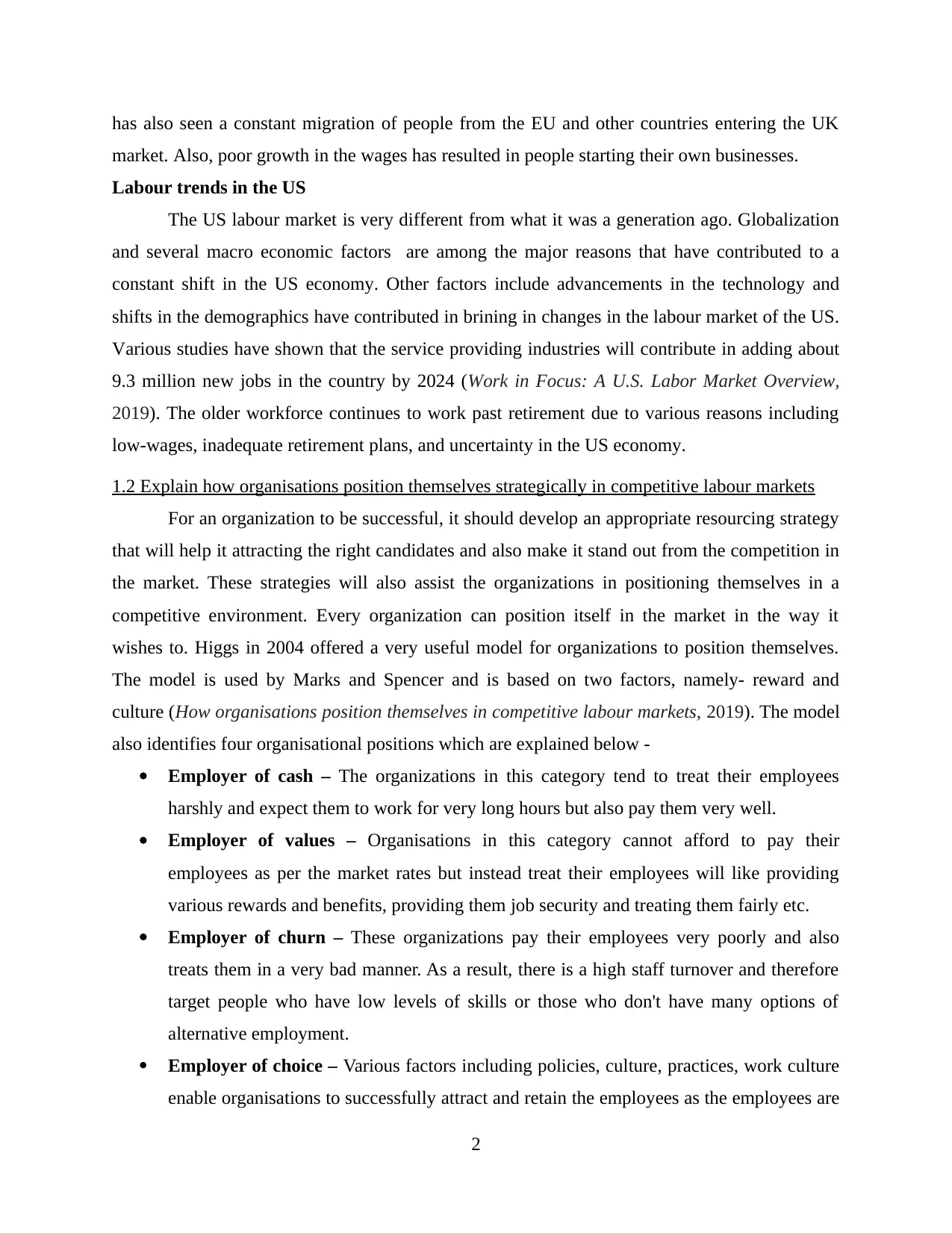
has also seen a constant migration of people from the EU and other countries entering the UK
market. Also, poor growth in the wages has resulted in people starting their own businesses.
Labour trends in the US
The US labour market is very different from what it was a generation ago. Globalization
and several macro economic factors are among the major reasons that have contributed to a
constant shift in the US economy. Other factors include advancements in the technology and
shifts in the demographics have contributed in brining in changes in the labour market of the US.
Various studies have shown that the service providing industries will contribute in adding about
9.3 million new jobs in the country by 2024 (Work in Focus: A U.S. Labor Market Overview,
2019). The older workforce continues to work past retirement due to various reasons including
low-wages, inadequate retirement plans, and uncertainty in the US economy.
1.2 Explain how organisations position themselves strategically in competitive labour markets
For an organization to be successful, it should develop an appropriate resourcing strategy
that will help it attracting the right candidates and also make it stand out from the competition in
the market. These strategies will also assist the organizations in positioning themselves in a
competitive environment. Every organization can position itself in the market in the way it
wishes to. Higgs in 2004 offered a very useful model for organizations to position themselves.
The model is used by Marks and Spencer and is based on two factors, namely- reward and
culture (How organisations position themselves in competitive labour markets, 2019). The model
also identifies four organisational positions which are explained below -
Employer of cash – The organizations in this category tend to treat their employees
harshly and expect them to work for very long hours but also pay them very well.
Employer of values – Organisations in this category cannot afford to pay their
employees as per the market rates but instead treat their employees will like providing
various rewards and benefits, providing them job security and treating them fairly etc.
Employer of churn – These organizations pay their employees very poorly and also
treats them in a very bad manner. As a result, there is a high staff turnover and therefore
target people who have low levels of skills or those who don't have many options of
alternative employment.
Employer of choice – Various factors including policies, culture, practices, work culture
enable organisations to successfully attract and retain the employees as the employees are
2
market. Also, poor growth in the wages has resulted in people starting their own businesses.
Labour trends in the US
The US labour market is very different from what it was a generation ago. Globalization
and several macro economic factors are among the major reasons that have contributed to a
constant shift in the US economy. Other factors include advancements in the technology and
shifts in the demographics have contributed in brining in changes in the labour market of the US.
Various studies have shown that the service providing industries will contribute in adding about
9.3 million new jobs in the country by 2024 (Work in Focus: A U.S. Labor Market Overview,
2019). The older workforce continues to work past retirement due to various reasons including
low-wages, inadequate retirement plans, and uncertainty in the US economy.
1.2 Explain how organisations position themselves strategically in competitive labour markets
For an organization to be successful, it should develop an appropriate resourcing strategy
that will help it attracting the right candidates and also make it stand out from the competition in
the market. These strategies will also assist the organizations in positioning themselves in a
competitive environment. Every organization can position itself in the market in the way it
wishes to. Higgs in 2004 offered a very useful model for organizations to position themselves.
The model is used by Marks and Spencer and is based on two factors, namely- reward and
culture (How organisations position themselves in competitive labour markets, 2019). The model
also identifies four organisational positions which are explained below -
Employer of cash – The organizations in this category tend to treat their employees
harshly and expect them to work for very long hours but also pay them very well.
Employer of values – Organisations in this category cannot afford to pay their
employees as per the market rates but instead treat their employees will like providing
various rewards and benefits, providing them job security and treating them fairly etc.
Employer of churn – These organizations pay their employees very poorly and also
treats them in a very bad manner. As a result, there is a high staff turnover and therefore
target people who have low levels of skills or those who don't have many options of
alternative employment.
Employer of choice – Various factors including policies, culture, practices, work culture
enable organisations to successfully attract and retain the employees as the employees are
2
Paraphrase This Document
Need a fresh take? Get an instant paraphrase of this document with our AI Paraphraser
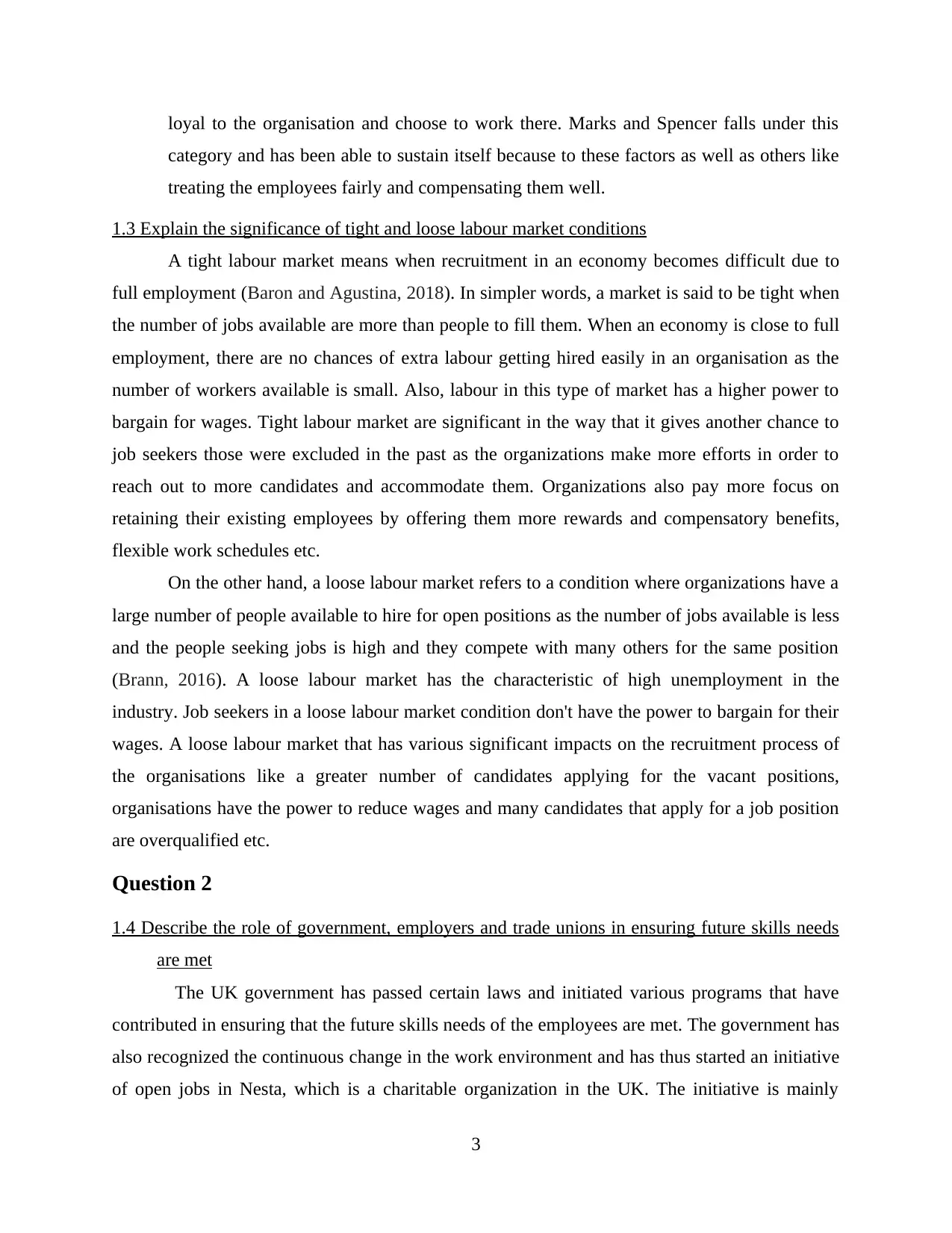
loyal to the organisation and choose to work there. Marks and Spencer falls under this
category and has been able to sustain itself because to these factors as well as others like
treating the employees fairly and compensating them well.
1.3 Explain the significance of tight and loose labour market conditions
A tight labour market means when recruitment in an economy becomes difficult due to
full employment (Baron and Agustina, 2018). In simpler words, a market is said to be tight when
the number of jobs available are more than people to fill them. When an economy is close to full
employment, there are no chances of extra labour getting hired easily in an organisation as the
number of workers available is small. Also, labour in this type of market has a higher power to
bargain for wages. Tight labour market are significant in the way that it gives another chance to
job seekers those were excluded in the past as the organizations make more efforts in order to
reach out to more candidates and accommodate them. Organizations also pay more focus on
retaining their existing employees by offering them more rewards and compensatory benefits,
flexible work schedules etc.
On the other hand, a loose labour market refers to a condition where organizations have a
large number of people available to hire for open positions as the number of jobs available is less
and the people seeking jobs is high and they compete with many others for the same position
(Brann, 2016). A loose labour market has the characteristic of high unemployment in the
industry. Job seekers in a loose labour market condition don't have the power to bargain for their
wages. A loose labour market that has various significant impacts on the recruitment process of
the organisations like a greater number of candidates applying for the vacant positions,
organisations have the power to reduce wages and many candidates that apply for a job position
are overqualified etc.
Question 2
1.4 Describe the role of government, employers and trade unions in ensuring future skills needs
are met
The UK government has passed certain laws and initiated various programs that have
contributed in ensuring that the future skills needs of the employees are met. The government has
also recognized the continuous change in the work environment and has thus started an initiative
of open jobs in Nesta, which is a charitable organization in the UK. The initiative is mainly
3
category and has been able to sustain itself because to these factors as well as others like
treating the employees fairly and compensating them well.
1.3 Explain the significance of tight and loose labour market conditions
A tight labour market means when recruitment in an economy becomes difficult due to
full employment (Baron and Agustina, 2018). In simpler words, a market is said to be tight when
the number of jobs available are more than people to fill them. When an economy is close to full
employment, there are no chances of extra labour getting hired easily in an organisation as the
number of workers available is small. Also, labour in this type of market has a higher power to
bargain for wages. Tight labour market are significant in the way that it gives another chance to
job seekers those were excluded in the past as the organizations make more efforts in order to
reach out to more candidates and accommodate them. Organizations also pay more focus on
retaining their existing employees by offering them more rewards and compensatory benefits,
flexible work schedules etc.
On the other hand, a loose labour market refers to a condition where organizations have a
large number of people available to hire for open positions as the number of jobs available is less
and the people seeking jobs is high and they compete with many others for the same position
(Brann, 2016). A loose labour market has the characteristic of high unemployment in the
industry. Job seekers in a loose labour market condition don't have the power to bargain for their
wages. A loose labour market that has various significant impacts on the recruitment process of
the organisations like a greater number of candidates applying for the vacant positions,
organisations have the power to reduce wages and many candidates that apply for a job position
are overqualified etc.
Question 2
1.4 Describe the role of government, employers and trade unions in ensuring future skills needs
are met
The UK government has passed certain laws and initiated various programs that have
contributed in ensuring that the future skills needs of the employees are met. The government has
also recognized the continuous change in the work environment and has thus started an initiative
of open jobs in Nesta, which is a charitable organization in the UK. The initiative is mainly
3
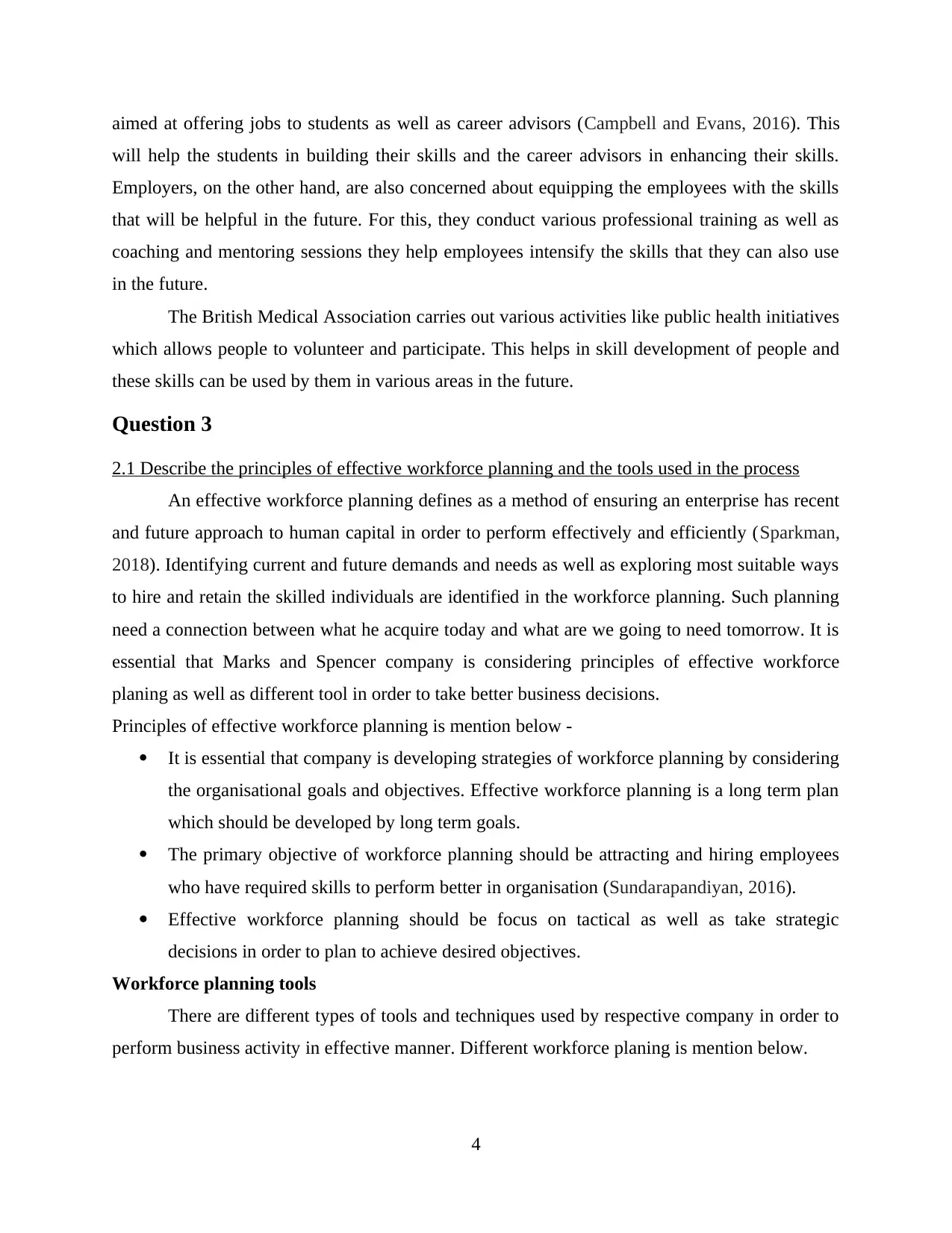
aimed at offering jobs to students as well as career advisors (Campbell and Evans, 2016). This
will help the students in building their skills and the career advisors in enhancing their skills.
Employers, on the other hand, are also concerned about equipping the employees with the skills
that will be helpful in the future. For this, they conduct various professional training as well as
coaching and mentoring sessions they help employees intensify the skills that they can also use
in the future.
The British Medical Association carries out various activities like public health initiatives
which allows people to volunteer and participate. This helps in skill development of people and
these skills can be used by them in various areas in the future.
Question 3
2.1 Describe the principles of effective workforce planning and the tools used in the process
An effective workforce planning defines as a method of ensuring an enterprise has recent
and future approach to human capital in order to perform effectively and efficiently (Sparkman,
2018). Identifying current and future demands and needs as well as exploring most suitable ways
to hire and retain the skilled individuals are identified in the workforce planning. Such planning
need a connection between what he acquire today and what are we going to need tomorrow. It is
essential that Marks and Spencer company is considering principles of effective workforce
planing as well as different tool in order to take better business decisions.
Principles of effective workforce planning is mention below -
It is essential that company is developing strategies of workforce planning by considering
the organisational goals and objectives. Effective workforce planning is a long term plan
which should be developed by long term goals.
The primary objective of workforce planning should be attracting and hiring employees
who have required skills to perform better in organisation (Sundarapandiyan, 2016).
Effective workforce planning should be focus on tactical as well as take strategic
decisions in order to plan to achieve desired objectives.
Workforce planning tools
There are different types of tools and techniques used by respective company in order to
perform business activity in effective manner. Different workforce planing is mention below.
4
will help the students in building their skills and the career advisors in enhancing their skills.
Employers, on the other hand, are also concerned about equipping the employees with the skills
that will be helpful in the future. For this, they conduct various professional training as well as
coaching and mentoring sessions they help employees intensify the skills that they can also use
in the future.
The British Medical Association carries out various activities like public health initiatives
which allows people to volunteer and participate. This helps in skill development of people and
these skills can be used by them in various areas in the future.
Question 3
2.1 Describe the principles of effective workforce planning and the tools used in the process
An effective workforce planning defines as a method of ensuring an enterprise has recent
and future approach to human capital in order to perform effectively and efficiently (Sparkman,
2018). Identifying current and future demands and needs as well as exploring most suitable ways
to hire and retain the skilled individuals are identified in the workforce planning. Such planning
need a connection between what he acquire today and what are we going to need tomorrow. It is
essential that Marks and Spencer company is considering principles of effective workforce
planing as well as different tool in order to take better business decisions.
Principles of effective workforce planning is mention below -
It is essential that company is developing strategies of workforce planning by considering
the organisational goals and objectives. Effective workforce planning is a long term plan
which should be developed by long term goals.
The primary objective of workforce planning should be attracting and hiring employees
who have required skills to perform better in organisation (Sundarapandiyan, 2016).
Effective workforce planning should be focus on tactical as well as take strategic
decisions in order to plan to achieve desired objectives.
Workforce planning tools
There are different types of tools and techniques used by respective company in order to
perform business activity in effective manner. Different workforce planing is mention below.
4
⊘ This is a preview!⊘
Do you want full access?
Subscribe today to unlock all pages.

Trusted by 1+ million students worldwide
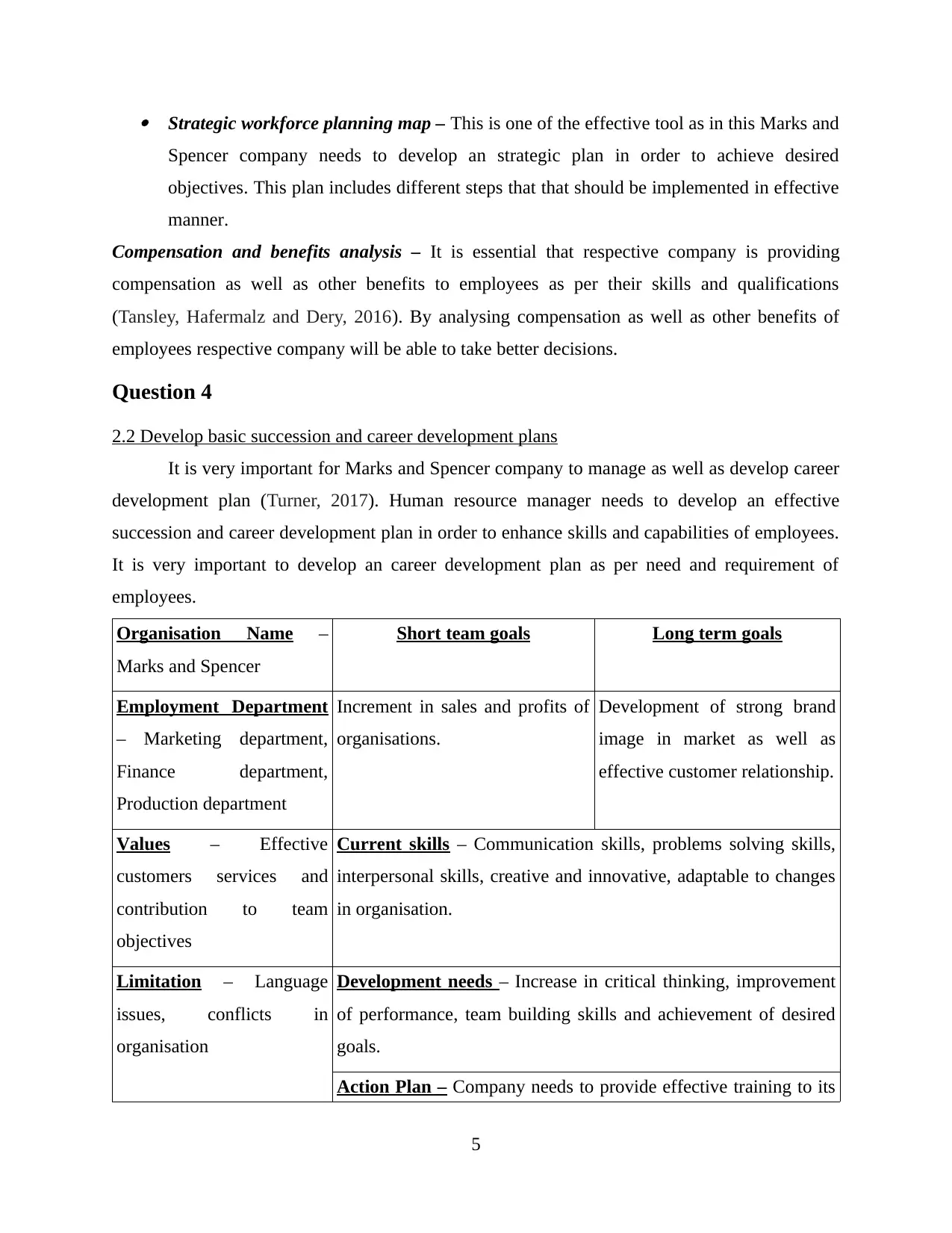
Strategic workforce planning map – This is one of the effective tool as in this Marks and
Spencer company needs to develop an strategic plan in order to achieve desired
objectives. This plan includes different steps that that should be implemented in effective
manner.
Compensation and benefits analysis – It is essential that respective company is providing
compensation as well as other benefits to employees as per their skills and qualifications
(Tansley, Hafermalz and Dery, 2016). By analysing compensation as well as other benefits of
employees respective company will be able to take better decisions.
Question 4
2.2 Develop basic succession and career development plans
It is very important for Marks and Spencer company to manage as well as develop career
development plan (Turner, 2017). Human resource manager needs to develop an effective
succession and career development plan in order to enhance skills and capabilities of employees.
It is very important to develop an career development plan as per need and requirement of
employees.
Organisation Name –
Marks and Spencer
Short team goals Long term goals
Employment Department
– Marketing department,
Finance department,
Production department
Increment in sales and profits of
organisations.
Development of strong brand
image in market as well as
effective customer relationship.
Values – Effective
customers services and
contribution to team
objectives
Current skills – Communication skills, problems solving skills,
interpersonal skills, creative and innovative, adaptable to changes
in organisation.
Limitation – Language
issues, conflicts in
organisation
Development needs – Increase in critical thinking, improvement
of performance, team building skills and achievement of desired
goals.
Action Plan – Company needs to provide effective training to its
5
Spencer company needs to develop an strategic plan in order to achieve desired
objectives. This plan includes different steps that that should be implemented in effective
manner.
Compensation and benefits analysis – It is essential that respective company is providing
compensation as well as other benefits to employees as per their skills and qualifications
(Tansley, Hafermalz and Dery, 2016). By analysing compensation as well as other benefits of
employees respective company will be able to take better decisions.
Question 4
2.2 Develop basic succession and career development plans
It is very important for Marks and Spencer company to manage as well as develop career
development plan (Turner, 2017). Human resource manager needs to develop an effective
succession and career development plan in order to enhance skills and capabilities of employees.
It is very important to develop an career development plan as per need and requirement of
employees.
Organisation Name –
Marks and Spencer
Short team goals Long term goals
Employment Department
– Marketing department,
Finance department,
Production department
Increment in sales and profits of
organisations.
Development of strong brand
image in market as well as
effective customer relationship.
Values – Effective
customers services and
contribution to team
objectives
Current skills – Communication skills, problems solving skills,
interpersonal skills, creative and innovative, adaptable to changes
in organisation.
Limitation – Language
issues, conflicts in
organisation
Development needs – Increase in critical thinking, improvement
of performance, team building skills and achievement of desired
goals.
Action Plan – Company needs to provide effective training to its
5
Paraphrase This Document
Need a fresh take? Get an instant paraphrase of this document with our AI Paraphraser
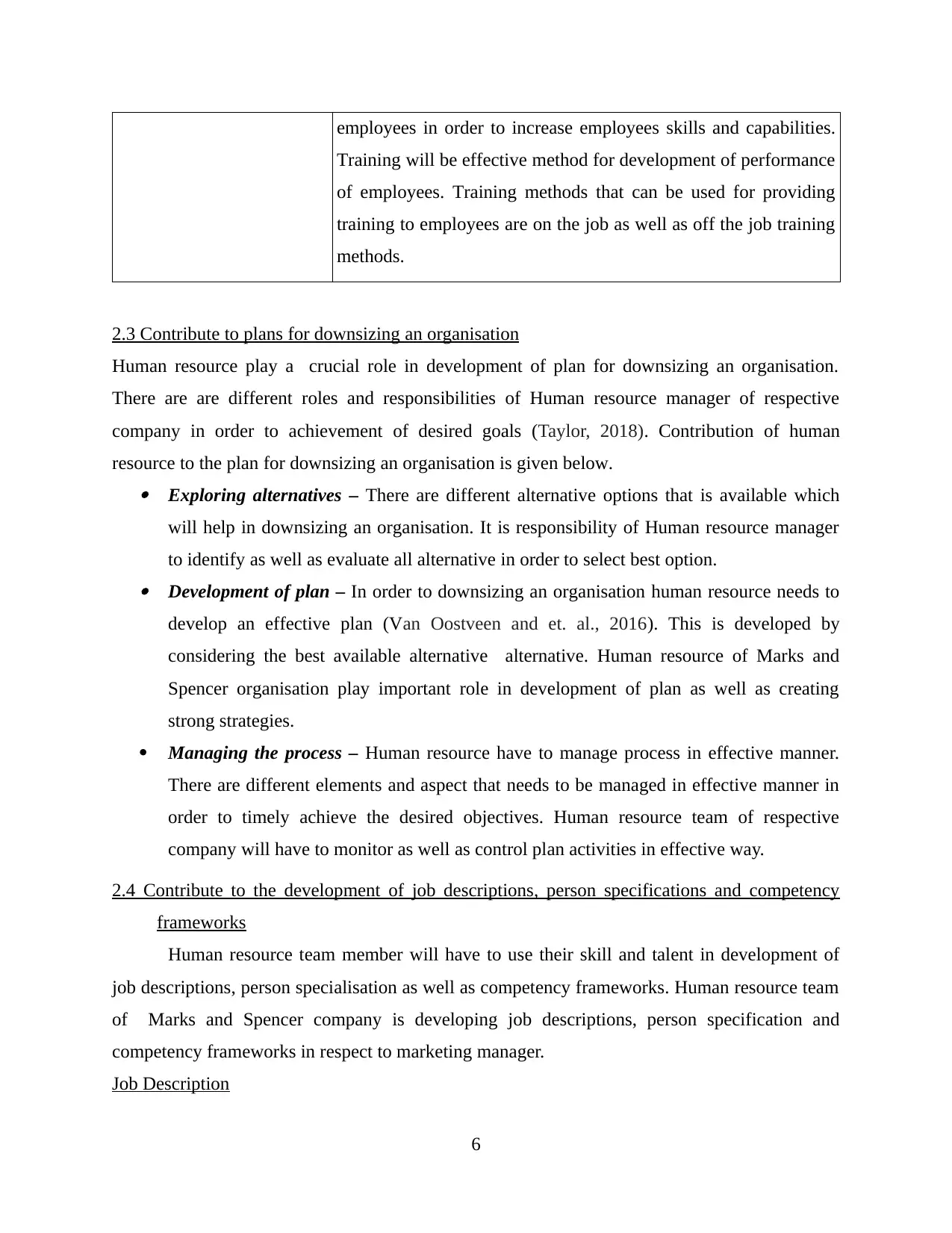
employees in order to increase employees skills and capabilities.
Training will be effective method for development of performance
of employees. Training methods that can be used for providing
training to employees are on the job as well as off the job training
methods.
2.3 Contribute to plans for downsizing an organisation
Human resource play a crucial role in development of plan for downsizing an organisation.
There are are different roles and responsibilities of Human resource manager of respective
company in order to achievement of desired goals (Taylor, 2018). Contribution of human
resource to the plan for downsizing an organisation is given below. Exploring alternatives – There are different alternative options that is available which
will help in downsizing an organisation. It is responsibility of Human resource manager
to identify as well as evaluate all alternative in order to select best option. Development of plan – In order to downsizing an organisation human resource needs to
develop an effective plan (Van Oostveen and et. al., 2016). This is developed by
considering the best available alternative alternative. Human resource of Marks and
Spencer organisation play important role in development of plan as well as creating
strong strategies.
Managing the process – Human resource have to manage process in effective manner.
There are different elements and aspect that needs to be managed in effective manner in
order to timely achieve the desired objectives. Human resource team of respective
company will have to monitor as well as control plan activities in effective way.
2.4 Contribute to the development of job descriptions, person specifications and competency
frameworks
Human resource team member will have to use their skill and talent in development of
job descriptions, person specialisation as well as competency frameworks. Human resource team
of Marks and Spencer company is developing job descriptions, person specification and
competency frameworks in respect to marketing manager.
Job Description
6
Training will be effective method for development of performance
of employees. Training methods that can be used for providing
training to employees are on the job as well as off the job training
methods.
2.3 Contribute to plans for downsizing an organisation
Human resource play a crucial role in development of plan for downsizing an organisation.
There are are different roles and responsibilities of Human resource manager of respective
company in order to achievement of desired goals (Taylor, 2018). Contribution of human
resource to the plan for downsizing an organisation is given below. Exploring alternatives – There are different alternative options that is available which
will help in downsizing an organisation. It is responsibility of Human resource manager
to identify as well as evaluate all alternative in order to select best option. Development of plan – In order to downsizing an organisation human resource needs to
develop an effective plan (Van Oostveen and et. al., 2016). This is developed by
considering the best available alternative alternative. Human resource of Marks and
Spencer organisation play important role in development of plan as well as creating
strong strategies.
Managing the process – Human resource have to manage process in effective manner.
There are different elements and aspect that needs to be managed in effective manner in
order to timely achieve the desired objectives. Human resource team of respective
company will have to monitor as well as control plan activities in effective way.
2.4 Contribute to the development of job descriptions, person specifications and competency
frameworks
Human resource team member will have to use their skill and talent in development of
job descriptions, person specialisation as well as competency frameworks. Human resource team
of Marks and Spencer company is developing job descriptions, person specification and
competency frameworks in respect to marketing manager.
Job Description
6
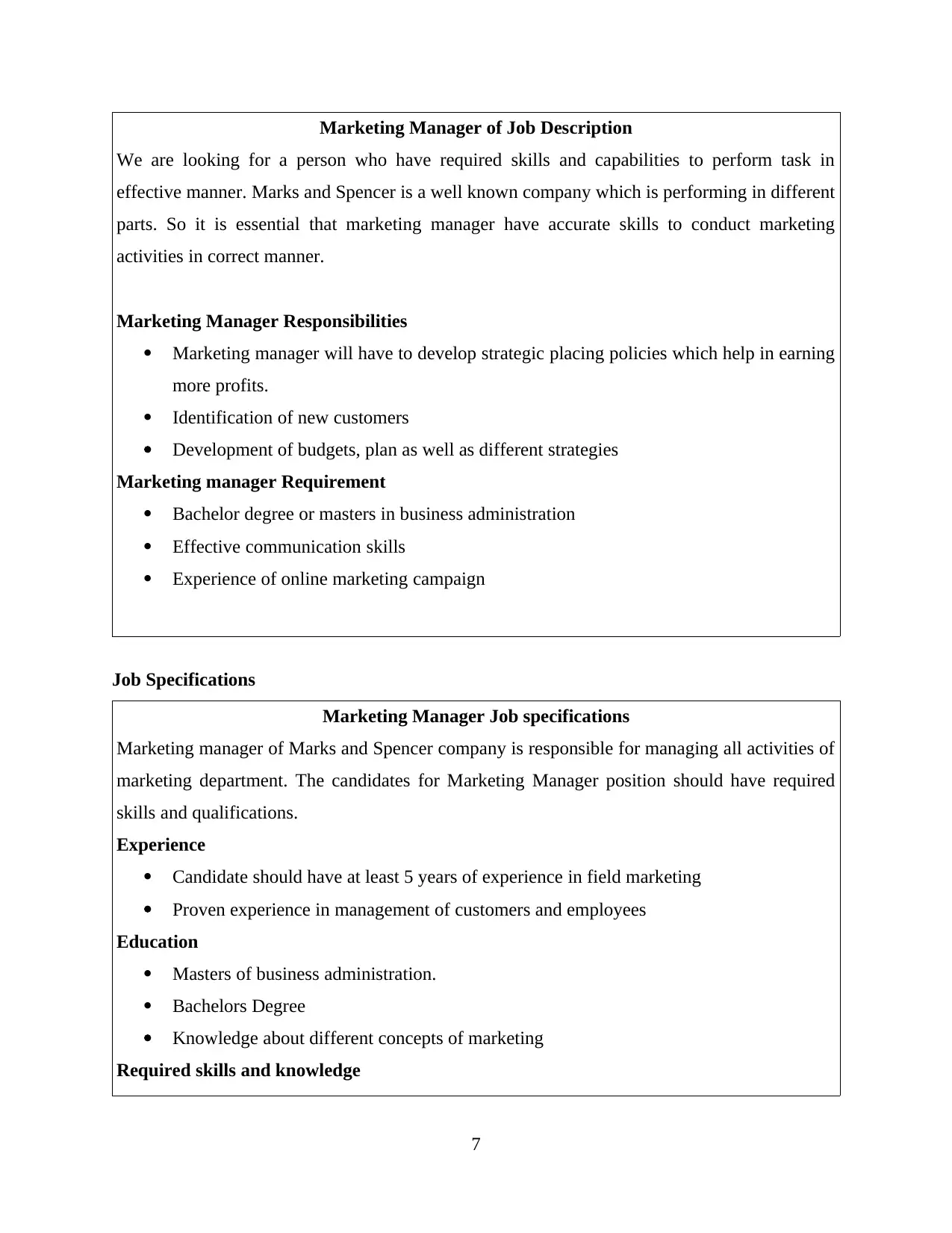
Marketing Manager of Job Description
We are looking for a person who have required skills and capabilities to perform task in
effective manner. Marks and Spencer is a well known company which is performing in different
parts. So it is essential that marketing manager have accurate skills to conduct marketing
activities in correct manner.
Marketing Manager Responsibilities
Marketing manager will have to develop strategic placing policies which help in earning
more profits.
Identification of new customers
Development of budgets, plan as well as different strategies
Marketing manager Requirement
Bachelor degree or masters in business administration
Effective communication skills
Experience of online marketing campaign
Job Specifications
Marketing Manager Job specifications
Marketing manager of Marks and Spencer company is responsible for managing all activities of
marketing department. The candidates for Marketing Manager position should have required
skills and qualifications.
Experience
Candidate should have at least 5 years of experience in field marketing
Proven experience in management of customers and employees
Education
Masters of business administration.
Bachelors Degree
Knowledge about different concepts of marketing
Required skills and knowledge
7
We are looking for a person who have required skills and capabilities to perform task in
effective manner. Marks and Spencer is a well known company which is performing in different
parts. So it is essential that marketing manager have accurate skills to conduct marketing
activities in correct manner.
Marketing Manager Responsibilities
Marketing manager will have to develop strategic placing policies which help in earning
more profits.
Identification of new customers
Development of budgets, plan as well as different strategies
Marketing manager Requirement
Bachelor degree or masters in business administration
Effective communication skills
Experience of online marketing campaign
Job Specifications
Marketing Manager Job specifications
Marketing manager of Marks and Spencer company is responsible for managing all activities of
marketing department. The candidates for Marketing Manager position should have required
skills and qualifications.
Experience
Candidate should have at least 5 years of experience in field marketing
Proven experience in management of customers and employees
Education
Masters of business administration.
Bachelors Degree
Knowledge about different concepts of marketing
Required skills and knowledge
7
⊘ This is a preview!⊘
Do you want full access?
Subscribe today to unlock all pages.

Trusted by 1+ million students worldwide
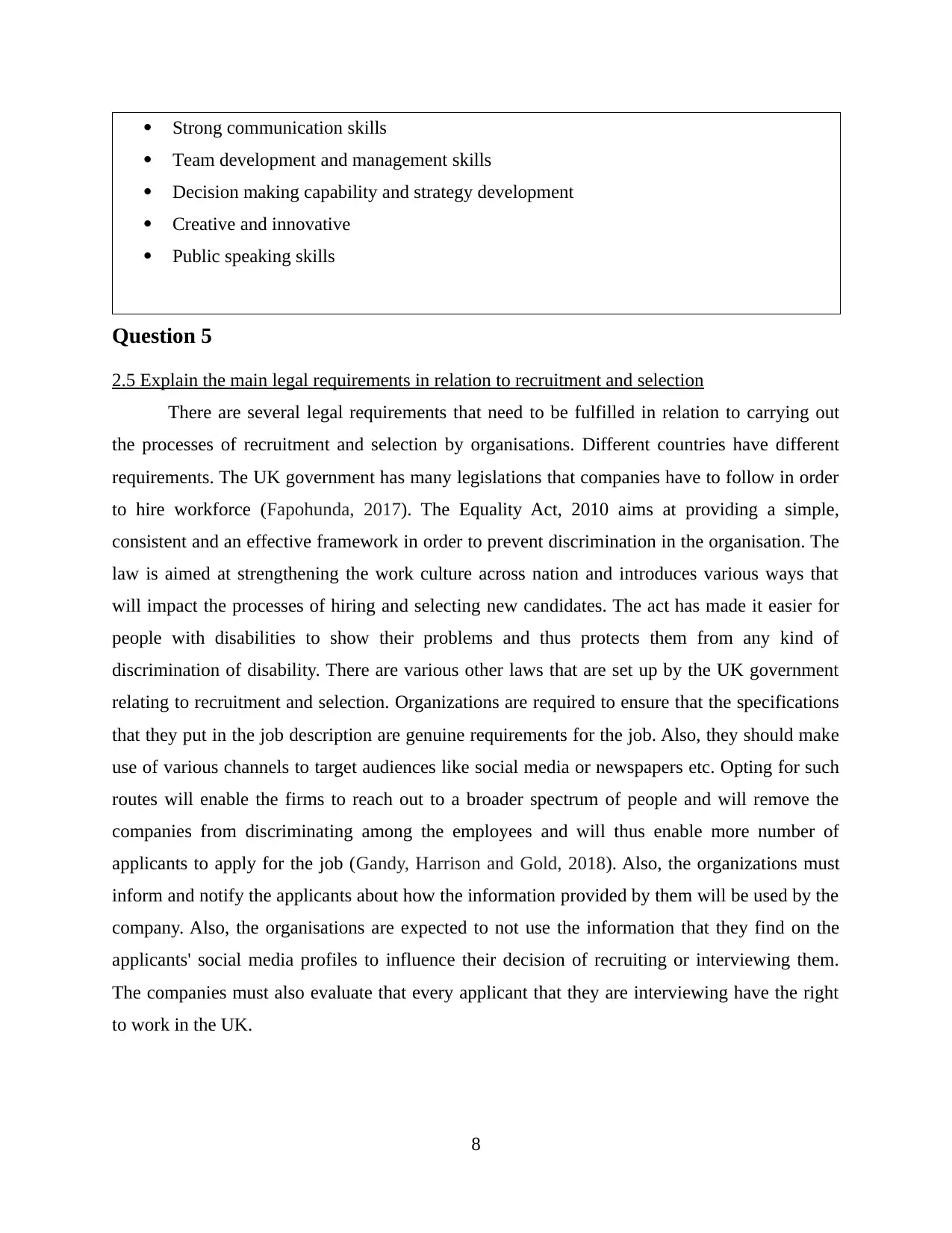
Strong communication skills
Team development and management skills
Decision making capability and strategy development
Creative and innovative
Public speaking skills
Question 5
2.5 Explain the main legal requirements in relation to recruitment and selection
There are several legal requirements that need to be fulfilled in relation to carrying out
the processes of recruitment and selection by organisations. Different countries have different
requirements. The UK government has many legislations that companies have to follow in order
to hire workforce (Fapohunda, 2017). The Equality Act, 2010 aims at providing a simple,
consistent and an effective framework in order to prevent discrimination in the organisation. The
law is aimed at strengthening the work culture across nation and introduces various ways that
will impact the processes of hiring and selecting new candidates. The act has made it easier for
people with disabilities to show their problems and thus protects them from any kind of
discrimination of disability. There are various other laws that are set up by the UK government
relating to recruitment and selection. Organizations are required to ensure that the specifications
that they put in the job description are genuine requirements for the job. Also, they should make
use of various channels to target audiences like social media or newspapers etc. Opting for such
routes will enable the firms to reach out to a broader spectrum of people and will remove the
companies from discriminating among the employees and will thus enable more number of
applicants to apply for the job (Gandy, Harrison and Gold, 2018). Also, the organizations must
inform and notify the applicants about how the information provided by them will be used by the
company. Also, the organisations are expected to not use the information that they find on the
applicants' social media profiles to influence their decision of recruiting or interviewing them.
The companies must also evaluate that every applicant that they are interviewing have the right
to work in the UK.
8
Team development and management skills
Decision making capability and strategy development
Creative and innovative
Public speaking skills
Question 5
2.5 Explain the main legal requirements in relation to recruitment and selection
There are several legal requirements that need to be fulfilled in relation to carrying out
the processes of recruitment and selection by organisations. Different countries have different
requirements. The UK government has many legislations that companies have to follow in order
to hire workforce (Fapohunda, 2017). The Equality Act, 2010 aims at providing a simple,
consistent and an effective framework in order to prevent discrimination in the organisation. The
law is aimed at strengthening the work culture across nation and introduces various ways that
will impact the processes of hiring and selecting new candidates. The act has made it easier for
people with disabilities to show their problems and thus protects them from any kind of
discrimination of disability. There are various other laws that are set up by the UK government
relating to recruitment and selection. Organizations are required to ensure that the specifications
that they put in the job description are genuine requirements for the job. Also, they should make
use of various channels to target audiences like social media or newspapers etc. Opting for such
routes will enable the firms to reach out to a broader spectrum of people and will remove the
companies from discriminating among the employees and will thus enable more number of
applicants to apply for the job (Gandy, Harrison and Gold, 2018). Also, the organizations must
inform and notify the applicants about how the information provided by them will be used by the
company. Also, the organisations are expected to not use the information that they find on the
applicants' social media profiles to influence their decision of recruiting or interviewing them.
The companies must also evaluate that every applicant that they are interviewing have the right
to work in the UK.
8
Paraphrase This Document
Need a fresh take? Get an instant paraphrase of this document with our AI Paraphraser
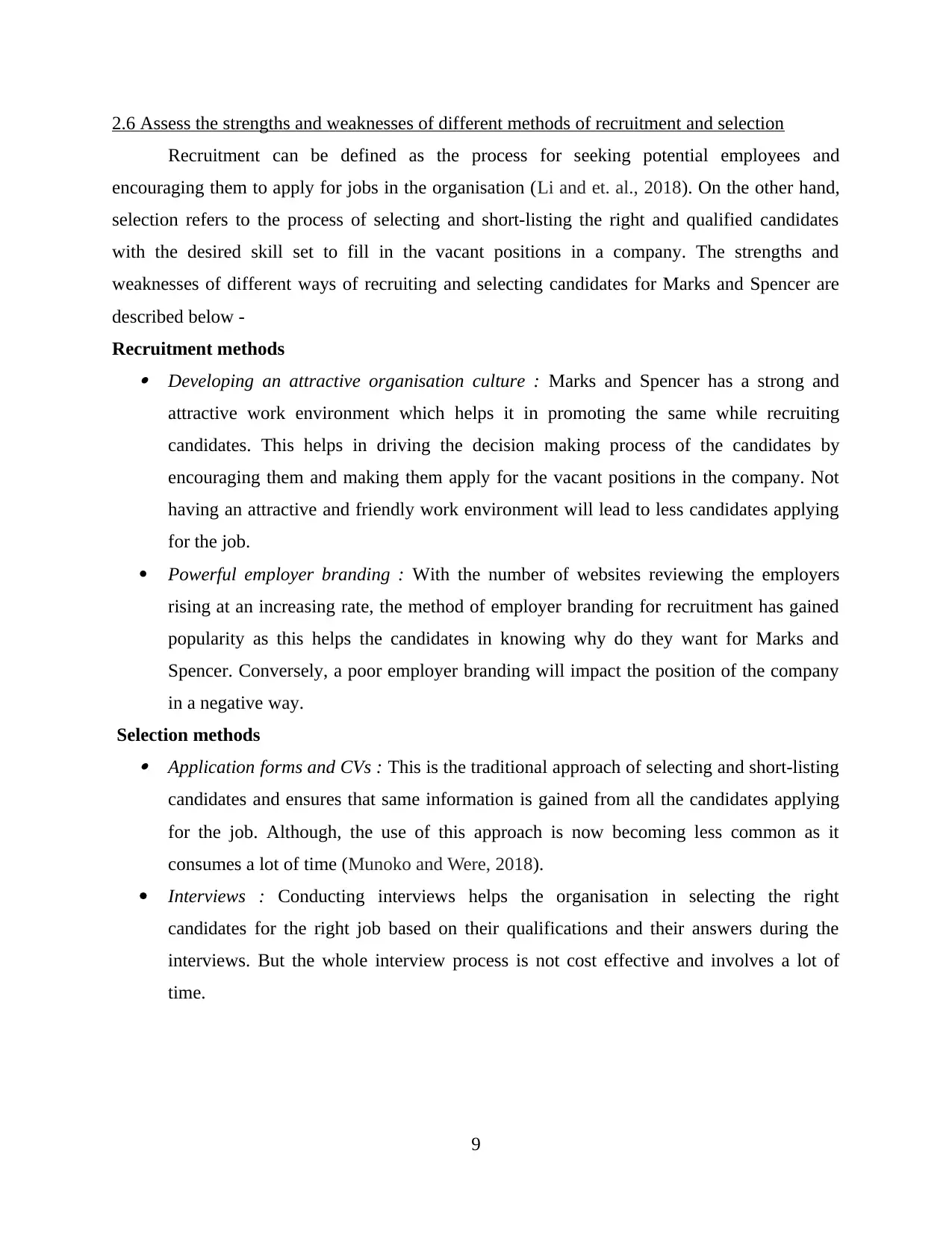
2.6 Assess the strengths and weaknesses of different methods of recruitment and selection
Recruitment can be defined as the process for seeking potential employees and
encouraging them to apply for jobs in the organisation (Li and et. al., 2018). On the other hand,
selection refers to the process of selecting and short-listing the right and qualified candidates
with the desired skill set to fill in the vacant positions in a company. The strengths and
weaknesses of different ways of recruiting and selecting candidates for Marks and Spencer are
described below -
Recruitment methods Developing an attractive organisation culture : Marks and Spencer has a strong and
attractive work environment which helps it in promoting the same while recruiting
candidates. This helps in driving the decision making process of the candidates by
encouraging them and making them apply for the vacant positions in the company. Not
having an attractive and friendly work environment will lead to less candidates applying
for the job.
Powerful employer branding : With the number of websites reviewing the employers
rising at an increasing rate, the method of employer branding for recruitment has gained
popularity as this helps the candidates in knowing why do they want for Marks and
Spencer. Conversely, a poor employer branding will impact the position of the company
in a negative way.
Selection methods Application forms and CVs : This is the traditional approach of selecting and short-listing
candidates and ensures that same information is gained from all the candidates applying
for the job. Although, the use of this approach is now becoming less common as it
consumes a lot of time (Munoko and Were, 2018).
Interviews : Conducting interviews helps the organisation in selecting the right
candidates for the right job based on their qualifications and their answers during the
interviews. But the whole interview process is not cost effective and involves a lot of
time.
9
Recruitment can be defined as the process for seeking potential employees and
encouraging them to apply for jobs in the organisation (Li and et. al., 2018). On the other hand,
selection refers to the process of selecting and short-listing the right and qualified candidates
with the desired skill set to fill in the vacant positions in a company. The strengths and
weaknesses of different ways of recruiting and selecting candidates for Marks and Spencer are
described below -
Recruitment methods Developing an attractive organisation culture : Marks and Spencer has a strong and
attractive work environment which helps it in promoting the same while recruiting
candidates. This helps in driving the decision making process of the candidates by
encouraging them and making them apply for the vacant positions in the company. Not
having an attractive and friendly work environment will lead to less candidates applying
for the job.
Powerful employer branding : With the number of websites reviewing the employers
rising at an increasing rate, the method of employer branding for recruitment has gained
popularity as this helps the candidates in knowing why do they want for Marks and
Spencer. Conversely, a poor employer branding will impact the position of the company
in a negative way.
Selection methods Application forms and CVs : This is the traditional approach of selecting and short-listing
candidates and ensures that same information is gained from all the candidates applying
for the job. Although, the use of this approach is now becoming less common as it
consumes a lot of time (Munoko and Were, 2018).
Interviews : Conducting interviews helps the organisation in selecting the right
candidates for the right job based on their qualifications and their answers during the
interviews. But the whole interview process is not cost effective and involves a lot of
time.
9
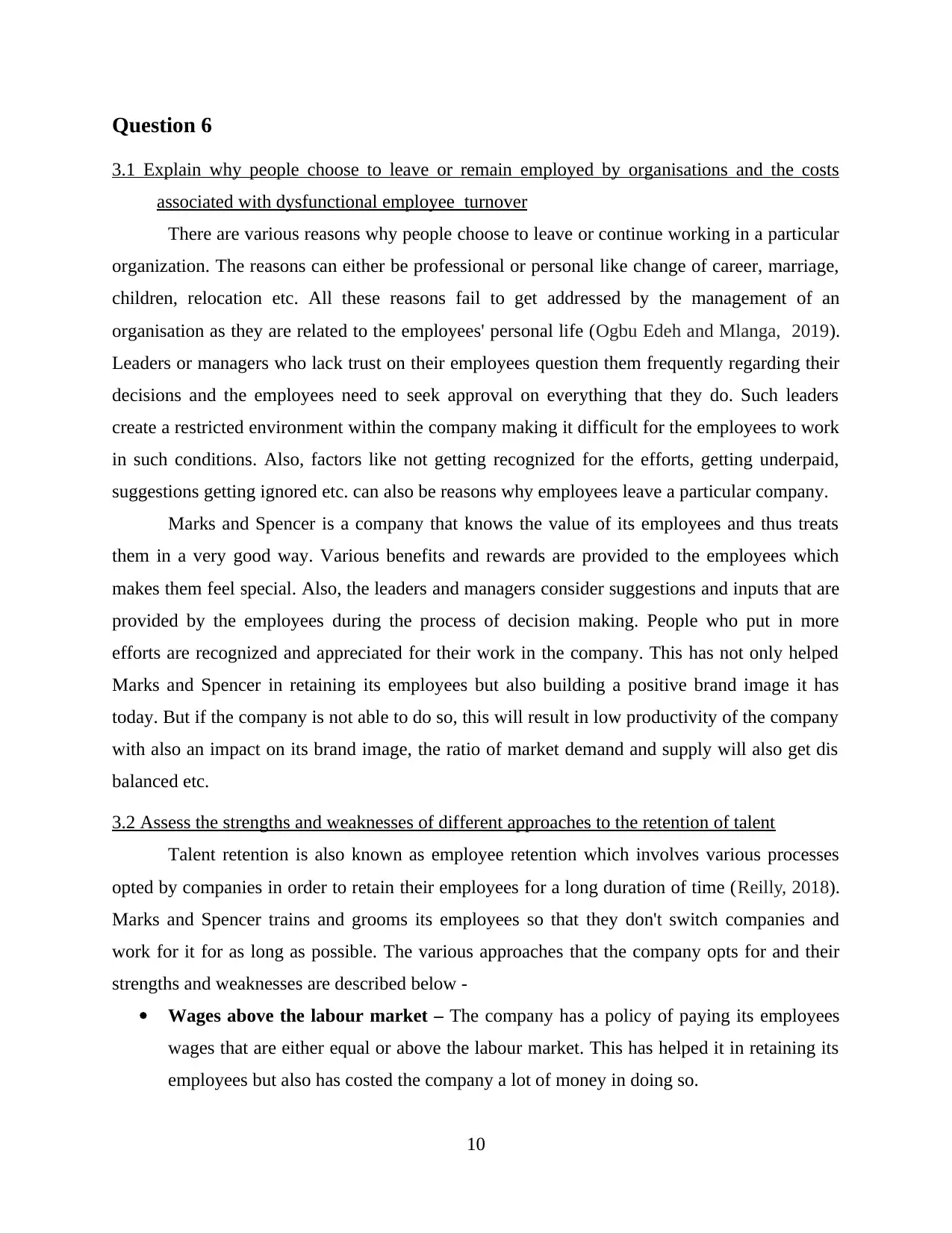
Question 6
3.1 Explain why people choose to leave or remain employed by organisations and the costs
associated with dysfunctional employee turnover
There are various reasons why people choose to leave or continue working in a particular
organization. The reasons can either be professional or personal like change of career, marriage,
children, relocation etc. All these reasons fail to get addressed by the management of an
organisation as they are related to the employees' personal life (Ogbu Edeh and Mlanga, 2019).
Leaders or managers who lack trust on their employees question them frequently regarding their
decisions and the employees need to seek approval on everything that they do. Such leaders
create a restricted environment within the company making it difficult for the employees to work
in such conditions. Also, factors like not getting recognized for the efforts, getting underpaid,
suggestions getting ignored etc. can also be reasons why employees leave a particular company.
Marks and Spencer is a company that knows the value of its employees and thus treats
them in a very good way. Various benefits and rewards are provided to the employees which
makes them feel special. Also, the leaders and managers consider suggestions and inputs that are
provided by the employees during the process of decision making. People who put in more
efforts are recognized and appreciated for their work in the company. This has not only helped
Marks and Spencer in retaining its employees but also building a positive brand image it has
today. But if the company is not able to do so, this will result in low productivity of the company
with also an impact on its brand image, the ratio of market demand and supply will also get dis
balanced etc.
3.2 Assess the strengths and weaknesses of different approaches to the retention of talent
Talent retention is also known as employee retention which involves various processes
opted by companies in order to retain their employees for a long duration of time (Reilly, 2018).
Marks and Spencer trains and grooms its employees so that they don't switch companies and
work for it for as long as possible. The various approaches that the company opts for and their
strengths and weaknesses are described below -
Wages above the labour market – The company has a policy of paying its employees
wages that are either equal or above the labour market. This has helped it in retaining its
employees but also has costed the company a lot of money in doing so.
10
3.1 Explain why people choose to leave or remain employed by organisations and the costs
associated with dysfunctional employee turnover
There are various reasons why people choose to leave or continue working in a particular
organization. The reasons can either be professional or personal like change of career, marriage,
children, relocation etc. All these reasons fail to get addressed by the management of an
organisation as they are related to the employees' personal life (Ogbu Edeh and Mlanga, 2019).
Leaders or managers who lack trust on their employees question them frequently regarding their
decisions and the employees need to seek approval on everything that they do. Such leaders
create a restricted environment within the company making it difficult for the employees to work
in such conditions. Also, factors like not getting recognized for the efforts, getting underpaid,
suggestions getting ignored etc. can also be reasons why employees leave a particular company.
Marks and Spencer is a company that knows the value of its employees and thus treats
them in a very good way. Various benefits and rewards are provided to the employees which
makes them feel special. Also, the leaders and managers consider suggestions and inputs that are
provided by the employees during the process of decision making. People who put in more
efforts are recognized and appreciated for their work in the company. This has not only helped
Marks and Spencer in retaining its employees but also building a positive brand image it has
today. But if the company is not able to do so, this will result in low productivity of the company
with also an impact on its brand image, the ratio of market demand and supply will also get dis
balanced etc.
3.2 Assess the strengths and weaknesses of different approaches to the retention of talent
Talent retention is also known as employee retention which involves various processes
opted by companies in order to retain their employees for a long duration of time (Reilly, 2018).
Marks and Spencer trains and grooms its employees so that they don't switch companies and
work for it for as long as possible. The various approaches that the company opts for and their
strengths and weaknesses are described below -
Wages above the labour market – The company has a policy of paying its employees
wages that are either equal or above the labour market. This has helped it in retaining its
employees but also has costed the company a lot of money in doing so.
10
⊘ This is a preview!⊘
Do you want full access?
Subscribe today to unlock all pages.

Trusted by 1+ million students worldwide
1 out of 16
Related Documents
Your All-in-One AI-Powered Toolkit for Academic Success.
+13062052269
info@desklib.com
Available 24*7 on WhatsApp / Email
![[object Object]](/_next/static/media/star-bottom.7253800d.svg)
Unlock your academic potential
Copyright © 2020–2025 A2Z Services. All Rights Reserved. Developed and managed by ZUCOL.





